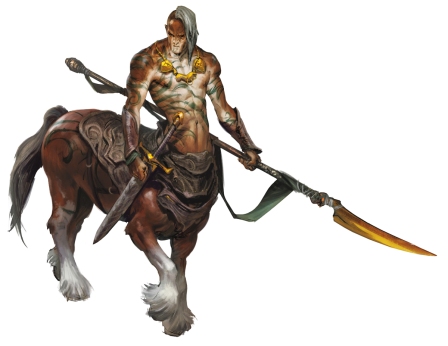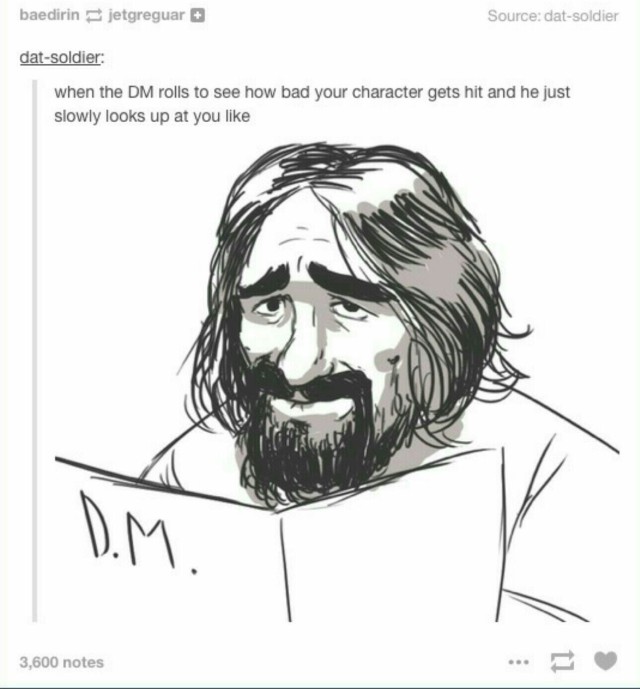
This will be the first, of a semi regular segment called Critical Miss, which I will discuss and analyze some of my worst failures as a DM. We all make them, but afterwards they can make a good story, plus many can serve as learning lessons.
This particular event occurred during my Lost City campaign. The party had just escaped from the pyramid, with a chain of captives, and was prepared to head to the nearest city, Calimshan; however, they needed to traverse through a wide swath of desert first.
Shortly into this journey a burly centaur, leading a group of bandits, waylaid the party, demanding money for passage.
The Cleric of the group (whose name I cannot remember), was played by the same person as the dead Fizzywinks (See the story behind the name article), approached the front of the gaggle of players and NPCs to bargain.
After a brief exchange, one of the party members said something rude to the centaur, offending him. The centaur charged at the Cleric, dealing triple damage, since this was 3.5 lance rules. Despite me rolling minimum damage, the Cleric was slain in this single strike, without any of the party having a chance to react. Starring in horror, the rest of the party quickly gave up the demanded tribute. The Cleric had, had the most hit-points in the group, so they knew they stood no chance.
My game had been notorious for being deadly; poor decisions, spats of bad luck, and the deadliness of first edition D&D adventures meant that characters dying was far from uncommon. My players actually joked that I relished the killing of new characters, as I took the character sheets as a trophy, even hanging them at times in my dorm room for all to see :).

This level of danger; however, was a completely new level. Never had anyone been one hit,and rarely had anyone died unless they made extremely poor decisions. While the Cleric’s player took the death well, at that moment I could see the confusion on his face. What had he done wrong, what error had been made, had they missed a clue? In a campaign I based on giving logical repercussions and reactions to player’s actions, this was completely illogical.
The reason behind this was simple. I had made a fatal error. Falling back on the Dungeon Master’s Guide, rather then my own intuition, I had attempted to make a deadly, yet conquerable encounter, following the confusing logic CR and ECL (the centaur had levels as a fighter). The end result was a horrifically unbalanced encounter which the players had no chance of beating AND to make matters worse, I had not purposefully designed it that way.
Right at the killing blow, part of me wanted to take back the encounter, rewind the game several moments, and give the party a chance. However, with the Cleric’s rapid death, the rest of the party had agreed paying for passage was far preferable.
While it was a tragedy the Cleric had been slain, I could see the newly restored caution instilled in my party. This came at a crucial time, as they had completed 1 major arc of the campaign, and were feeling quite powerful, this knocked them down a few notches, which in the long run might improve the game. Also, the Cleric’s player was shortly going to be ceasing playing and instead joining me as a DM assistant. I made the split second decision to stick too my guns and keep the Cleric killed. After the session I told the Cleric’s player that encounter was flawed on my part, and I had not meant him to die, luckily he understood.
Some lessons and thoughts.
1- I am glad that the 5th edition encounter balancing equation makes a lot more sense. ECL plus CR never made any sense and CR always seemed off.
2- When your institution says an encounter is too difficult, even if the rules says it shouldn’t be, go with your gut. As the group’s DM you know their capabilities best.
3- Be extremely careful when applying character levels to monsters, as it is a much bigger power boost then it may initially seem.
4- Finally, take the time to examine the damage output of your encounters. How quickly can your players lose characters if all goes well for the monsters? This is a great way to eye ball encounter difficulty, or at least block majorly unbalanced encounters, after all, rarely should you be wanting to one hit your players into oblivion.
Well, hopefully reading about my mistake has been amusing, maybe given some insight into DMing. I am sure the Cleric’s player will appreciate the public admission of guilt in his slaying; however, Fizzywinks, you and I both know that character was a dick and had it coming :).

To be fair this is the guy that released salamanders and fire genies on an inspecting populace. He made a bad deal or two and ended up committing genocide.
He also convinced the survivors of the attack to follow him so they could be sold into slavery. He wasn’t a good guy. Unless of course he could convince you to follow his god.
LikeLike
exactly!
LikeLike
For those of us that weren’t DMs back in the day, what is ECL and CR? I was only ever a player in those days!
LikeLike
Jon, good question :). ECL stood for Effective Character Level, which was supposed to be a way to judge what a monster with character levels added would effectively be in terms of character level. The way to figure this out was wordy, and pretty complicated.
CR i believe stands for Creature Rating. No matter what the letters stand for, it was, and actually still is, used as a guideline for difficulty rating vs. players. The idea was that a creature’s CR meant it would be a moderate challenge for a group of 4 players of level equal to the CR. Problems; however, arose when you wanted multiple creatures, or wanted to increase the power of a lower CR monster, which is what happened to me.
Both of these systems in 3.5 would then plug into a chart, which was supposed to show you how many of X creature + Y creature would create an appropriate challenge for a party of level Z; however, they system was pretty unbalanced in my experience.
LikeLike
Oh, in 5th I think they call it “Challenge Rating”. Thanks!
LikeLike
Oh yes that is right, in 3.5 it was also Challenge Rating 🙂
LikeLike